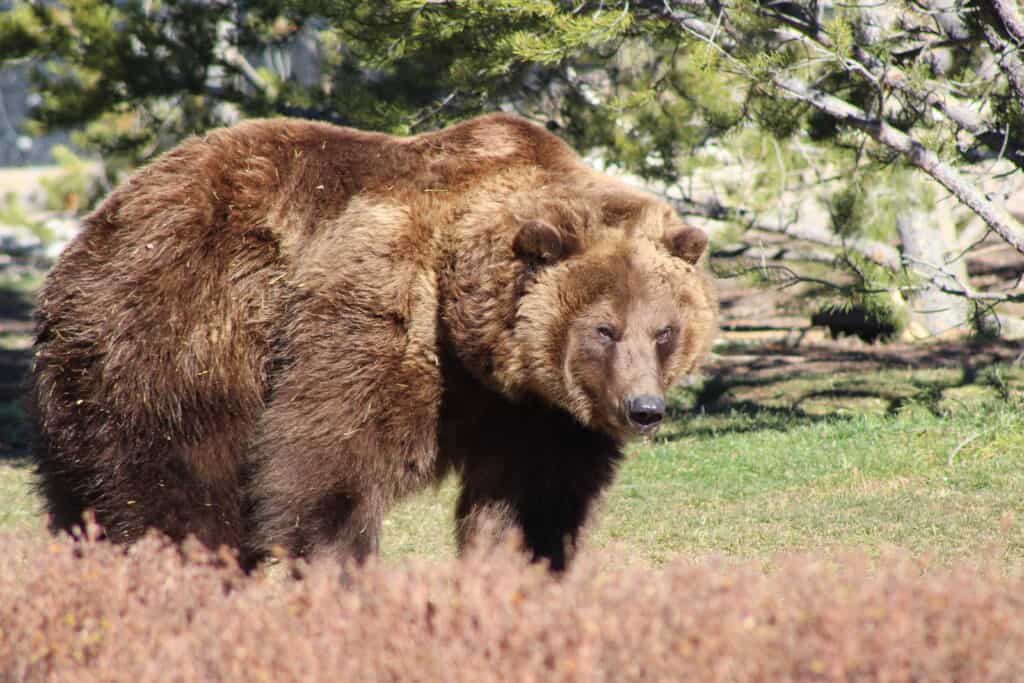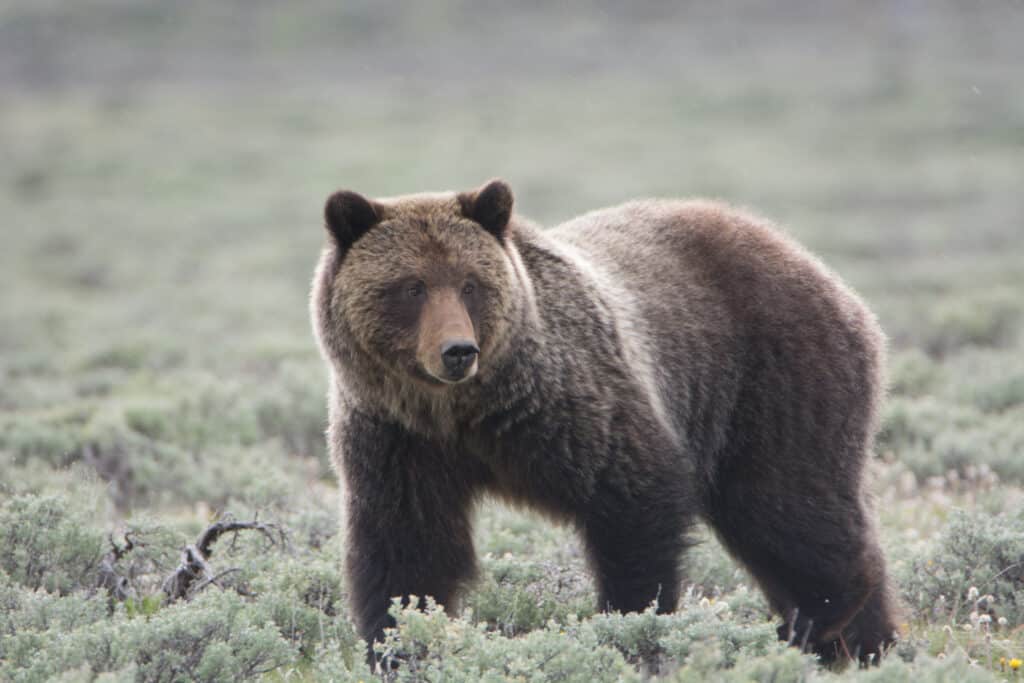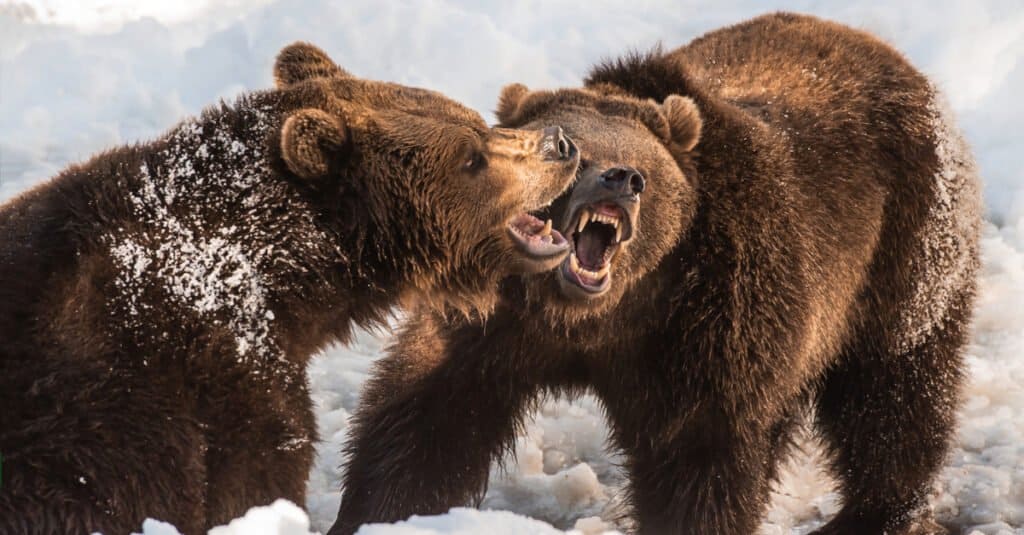Sometimes, members of a species start to change if they are left alone in a single part of the world for long enough. That is the case with the Kodiak bear, a subspecies of brown bears that have become the second-largest type of bear in the world today. They are only surpassed by the polar bear. Meanwhile, the term “Yellowstone bears” refers to the grizzly bear or black bear population in Yellowstone National Park. These bears represent typical sizes for their species. Today, we’re going to imagine an epic battle between these Yellowstone bears vs. a Kodiak bear and see how the larger animal would fare.
To make things more even, we’re going to use data about grizzly bears for the Yellowstone bears, ultimately pitting two types of brown bear against each other!
Comparing Yellowstone Bears and a Kodiak Bear
| Yellowstone Bears | Kodiak Bear | |
|---|---|---|
| Size | Weight: 400 to 700 pounds, up to 1,200 at their utmost Height: About 3 to 4.5 feet in height, measured at the shoulders Length: From 6 to 10 feet | Weight: 600 to 1,400 pounds, up to 1,600 pounds Height: 4.4 to 5 feet at the shoulder Length: About 8 to 10 feet long |
| Speed | May sprint at 35 mph in pursuit of prey | Roughly 30 mph at maximum speed |
| Defenses | – Has thick fur and skin to reduce puncture damage – Can traverse water and land – The bear’s large body dissuades attacks from other creatures – Uses a scary standing threat display to frighten off others | – Dense fur, thick skin, and fat layer – Can travel on land and water – Their size and propensity for violence have made them apex predators in their range – Also has a threat response that can frighten off other members of their species |
| Offensive Capabilities | – Has 42 teeth with 3-inch-long fangs – Can bite with a force of 975 PSI – Has massive paws, long claws, and a lot of raw power with which to smash and cause prey to move – Uses a multi-faceted assault with bites, smacks, slashes, shaking, and more to kill prey | – Uses a mauling attack with clawing, biting, smacking, and shaking to kill larger prey – Bite force of 930 to 975 PSI – Massive body allows them to take down other animals |
| Predatory Behavior | Opportunistic predator, but it mostly gathers food and scavenges | Typically, they are opportunistic hunters that range for many miles to find prey or simply eat vegetation, fish, or carrion |
What Is the Key Difference Between Yellowstone Bears and a Kodiak Bear?
The most significant differences between Yellowstone bears and Kodiak bears can be found in their size. Kodiak bears are larger than Yellowstone bears, weighing between 600 and 1,400 pounds, with their maximum measured size being 1,600 pounds. Also, Kodiak bears average between 4.4 and 5 feet tall at the shoulder and grow between 8 and 10 feet long.
Meanwhile, Yellowstone bears have an average weight between 400 and 700 pounds, but they have reached about 1,200 at their very largest. Also, they measure about 3 to 4.5 feet in height and grow between 6 and 10 feet long. All told, the size difference between these animals is their only main difference since they are both essentially brown bears.
Of course, the other difference in this fight is the number of fighters on each side, and we’ll be sure to cover that element as well.

The size of Kodiak bears and their propensity for violence has made them apex predators in their range.
©iStock.com/Jess Bray
What Are the Key Factors in a Fight Between Yellowstone Bears and a Kodiak Bear?
The most significant factors in a battle between Yellowstone bears and Kodiak bears are size and the number of fighters. However, those are not the only factors that we should consider. Instead, we’ll focus on a broad number of different elements that will provide a well-rounded look at the battle.
We’re going to assess five factors, assign advantages to each creature, and use that information to determine the overall winner of the fight.
Yellowstone Bears vs. Kodiak Bear: Size
The average Kodiak bear is far larger than a Yellowstone bear. The average Kodiak bear weighs in at about 600 pounds, but the average Yellowstone bear can weigh as little as 400 pounds. The higher weights make this disparity even higher. The Kodiak bear can tip the scales at 1,400 pounds, but grizzlies are lucky if they get up to 1,000 pounds at all.
Both bears top out at 10 feet long, but it’s more likely for a Kodiak bear to reach this measure than a Yellowstone bear. Also, the grizzly bear can measure between 3 and 4.5 feet tall at the shoulder, but the Kodiak bear can measure from 4.4 feet to 5 feet at the shoulder on average.
The Kodiak bear has the advantage in size over the Yellowstone bear.

Kodiak bears are larger than Yellowstone bears, weighing between 600 and 1,400 pounds, with their maximum measured size being 1,600 pounds.
©Lisa Stoorza/Shutterstock.com
Yellowstone Bears vs. Kodiak Bear: Speed
Yellowstone bears are slightly faster than Kodiak bears. When pursuing prey, grizzly bears can run at speeds of about 35 mph. Kodiak bears have been clocked at 30 mph. The difference in speed is not that great, but it technically favors the Yellowstone bear.
Yellowstone bears have a speed advantage over Kodiak bears.

Yellowstone bears like the grizzly are slightly faster than Kodiak bears reaching speeds of about 35 mph.
©Jilll Richardson/Shutterstock.com
Yellowstone Bears vs. Kodiak Bear: Defenses
For the most part, Yellowstone and Kodiak bears have very similar defenses. They rely on their size and apparent ferocity to scare away their enemies. Yet, they also have thick skin, dense fur, and a layer of fat that protects them from harm to an extent. Since the Kodiak bear is larger and heavier, it is no stretch of the imagination to say that this bear has better defenses since it has a thicker layer of fat, a bigger body, and probably a thicker hide.
Kodiak bears have a defensive advantage over Yellowstone bears.
Yellowstone Bears vs. Kodiak Bear: Offensive Capabilities
Again, Yellowstone bears and Kodiak bears are very similar in their offensive capabilities. When they do decide to kill animals for food, they use a multi-faceted mauling attack to kill. These attacks integrate bites, shaking, powerful smacks, claw slashes, and even the body weight of the bear.
The size favors the Kodiak bear since larger bears are likely to have more power along with longer claws and teeth.
Kodiak bears have the offensive advantage.

Both Yellowstone bears and Kodiak bears fight by biting, shaking, using powerful smacks, claw slashes, and leveraging body weight.
©Alexandra Giese/Shutterstock.com
Yellowstone Bears vs. Kodiak Bear: Predatory Behavior
Both Yellowstone bears and Kodiak bears are more likely to find food than hunt for it. They both hunt prey, though. They are opportunistic predators that range over many miles to find food. When they do find prey, they’ll chase it down and violently kill it by mauling or biting the back or neck of the animal to swiftly end the fight. In that sense, they are both very similar in how they hunt.
Yellowstone bears and Kodiak bears are tied in predatory behavior.
Who Would Win in a Fight Between Yellowstone Bears and a Kodiak Bear?
The Yellowstone bears would win a battle against a Kodiak bear as long as more than one Yellowstone grizzly is fighting the Kodiak bear at once, and the bears are set on fighting. In a typical situation, the Yellowstone grizzly bears would back down because of the potential danger of confronting a larger bear.
This fight comes down to how many Yellowstone bears face off against the Kodiak bear. Of course, their ranges don’t overlap. Yet, we’ll imagine that a small group of three Yellowstone bears pursuing a feast at a salmon run happen to find a lone Kodiak bear defending an elk corpse.
Yellowstone grizzlies aren’t known for cooperating to fight, so they don’t get points for coordination like that exhibited by a wolf pack. Still, if they were fighting against the Kodiak, they would win. Simply put, they would overwhelm the Kodiak bear with bites, slashes, powerful smacks, and their body weight. The Kodiak would win a fight one-on-one, and it may dissuade one of the bears from attacking out of a sense of self-preservation, but it can’t defend itself from several directions at once, or the combined might of two or more Yellowstone bears bent on killing it.
The other two bears would cause so much damage that the Kodiak bear would flee or die trying to keep its kill.
Could Anyone Beat a Group of Yellowstone Bears in Battle?
The Yellowstone bears are known for their strength and ferocity, making them formidable opponents. But who could beat such an impressive group of animals? It is likely that other large predators, such as wolves or mountain lions, have the capability to win in this theoretical battle. Wolves often hunt in packs which can give them a greater advantage over lone bears, so they may be able to use numbers to overtake the bear group. Mountain Lions are also fierce hunters with remarkable speed and agility, which may help them outwit slower-moving bears. Ultimately, it would depend on how many animals were pitted against each other and what strategies they employed during combat.
What Wild Animals Can a Human Defeat Barehanded?

In polls, the general consensus is that humans feel the least confident in fighting a grizzly bear barehanded.
©Jack Nevitt/Shutterstock.com
As we’ve discovered, the Yellowstone (grizzly) bear is likely outmatched when going one-on-one against a Kodiak bear. But how about a human? What wild animals could a human triumph over in hand-to-hand (or paw) combat? People don’t like to purposely put themselves in harm’s way, as our instinct, just like wild animals, is survival. While gladiators put themselves in jeopardy by battling wild animals in ancient times, we modern-day folks can only imagine what animals we think we could beat out.
An interesting poll was taken of Americans by YouGov asking them what animals they believed they could beat in a fight. The results were as follows:
- Rat – 72%
- House Cat – 69%
- Goose – 71%
- Medium-Sized Dog – 49%
- Eagle – 30%
- Large Dog – 23%
- Chimpanzee – 17%
- King Cobra – 15%
- Kangaroo – 14%
- Wolf – 12%
- Crocodile – 9%
- Gorilla – 8%
- Elephant – 8%
- Lion – 8%
- Grizzly Bear – 6%
As you can see, grizzly bears are the lowest on the list of animals humans believe they can conquer in a fight. The number one animal most Americans think they can defeat is a rat! Ha! Also, “house cat” is an interesting label, as it leaves out feral cats. Those poor domestic kitties!
While people, especially men, enjoy imagining what wild animals they could kill barehanded, we’d like to give props to Travis Kaufman, a Colorado jogger who was attacked by a mountain lion while jogging and actually killed the animal with his bare hands! The attack happened in 2019, and his battle made national news. We now know that it is possible for a human to kill a mountain lion with his bare hands. Amazing!
The photo featured at the top of this post is © Dennis W Donohue/Shutterstock.com
Sources
- National Park Service, Available here: https://www.nps.gov/yell/learn/nature/grizzlybear.htm#:~:text=Yellowstone%20is%20home%20to%20two,range%20across%20the%20United%20States
- The National Wildlife Federation, Available here: https://www.nwf.org/Educational-Resources/Wildlife-Guide/Mammals/Grizzly-Bear
- Alaska Department of Fish and Game, Available here: https://www.adfg.alaska.gov/index.cfm?adfg=brownbear.trivia
Thank you for reading! Have some feedback for us? Contact the AZ Animals editorial team.






